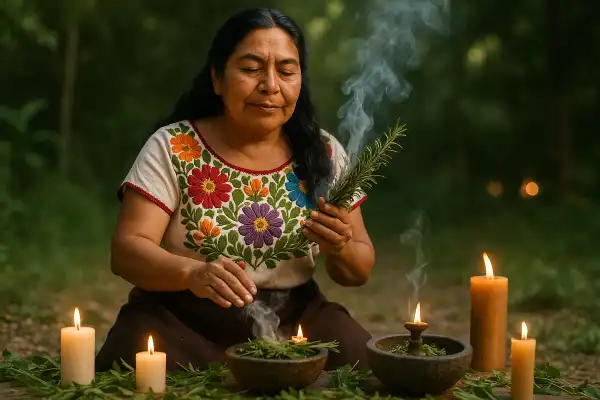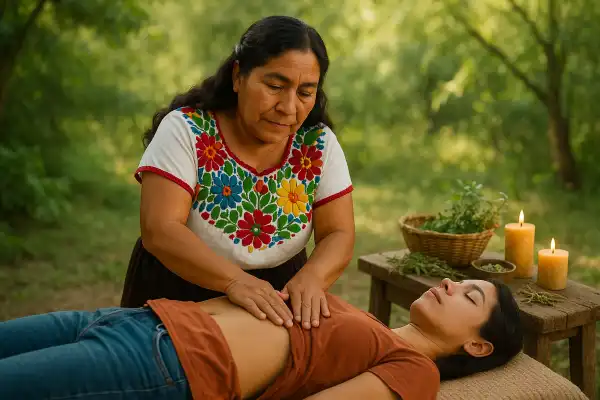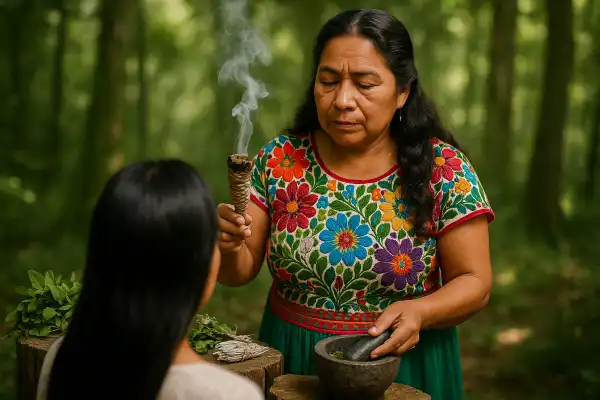Curanderismo folk healing represents a profound indigenous wisdom that has flourished for over 5,000 years, weaving together the sacred threads of pre-Columbian knowledge, plant medicine, and spiritual understanding. Many people today seek answers beyond conventional medicine, yearning for healing approaches that honor the interconnectedness of body, mind, and spirit.
María del Pilar Fernández, a dedicated cultural anthropologist and practitioner raised within a lineage of curanderas in Oaxaca, believes deeply in the transformative power of these ancestral healing arts. Through her lifelong immersion in curanderismo and her commitment to preserving indigenous Mexican wisdom, she seeks to answer the essential question of what curanderismo folk healing truly encompasses and how it can restore balance in our contemporary world.
Curanderismo folk healing
Curanderismo folk healing is a holistic traditional healing system that has been practiced in Mexico and Latin America for centuries, combining indigenous Mesoamerican healing practices with elements introduced during Spanish colonization. This comprehensive approach to wellness addresses physical, emotional, mental, and spiritual ailments through natural remedies, energy healing, and sacred rituals.

The heart of curanderismo lies in its understanding that healing extends far beyond treating symptoms. Practitioners, known as curanderos and curanderas, work to restore harmony and balance through the belief that the body, mind, and spirit are interconnected, and that illness often results from spiritual imbalance. This ancient wisdom recognizes that true healing requires addressing the whole person within their cultural, familial, and spiritual context.
Historical roots and cultural foundations
Curanderismo’s origins trace back to the Archaic Period of Mesoamerica, with evidence of sophisticated healing practices among the Olmec civilization around 1,200 BCE. The tradition evolved through the great indigenous civilizations of the Aztecs and Maya, who developed complex understanding of herbal medicine, surgical procedures, and spiritual healing practices.
The Spanish colonization period brought significant changes, as indigenous healing practices merged with Catholic elements and European medical knowledge. Rather than destroying the traditional wisdom, this cultural synthesis created the rich tapestry of practices we recognize today as curanderismo. Mexican traditional healing now represents both the medicine that came from Europe and the medicine that originated in this land, coming together in a powerful healing tradition.
Core principles and worldview
Eight fundamental philosophical principles underlie curanderismo’s approach to healing and patient care. These include the understanding that strong emotional states or life transitions can cause illness, that maintaining balance with one’s environment is essential for health, and that patients may sometimes be innocent victims of harmful spiritual forces.
The tradition also recognizes that illness often serves social functions, such as bringing families together or facilitating personal growth through challenge. Latino patients typically respond better to open, personal interactions with their healers, reflecting the importance of relationship and trust in the healing process. These principles align with indigenous healing systems worldwide, emphasizing the interconnectedness of mind, body, family, ancestors, and the spirit world.
Traditional healing practices and modalities
Curanderismo encompasses diverse healing modalities, each addressing different aspects of human wellness. The practices vary by region, practitioner specialization, and individual need, but certain core techniques remain consistent throughout Mexican traditional healing.
Limpias: spiritual cleansing rituals
Limpias, or spiritual cleansings, represent one of the most common and essential practices in curanderismo, designed to remove negative energy and spiritual blockages that cause physical, emotional, or spiritual ailments. These practical and effective shamanic cleanses heal, purify, and revitalize people and spaces using herbs, flowers, eggs, feathers, fire, and water.
During a limpia, the curandero may wave bundles of herbs such as sage or rosemary over the person while reciting prayers, with the smoke from burning herbs believed to purify the individual and restore energetic balance. The ritual may also incorporate sacred objects such as crystals, candles, and feathers, which are believed to hold spiritual energy and amplify the cleansing effects.
Sobaderas and traditional massage
Sobaderas are curanderos who specialize in massage and acupressure techniques, though sobaderismo treatments extend far beyond physical healing to release emotional, spiritual, mental, and physical wounds that may be stored in the cellular body, spirit, and soul. Traditional sobadas (massages) work alongside other healing modalities such as manteadas (shawl alignments) and ventosas (fire cupping).

The loving touch employed in sobaderismo serves multiple healing purposes, as it has a tendency to melt hardness and stubbornness and can be incredibly effective in facilitating limpias and soul retrieval. This hands-on approach recognizes that physical touch, when applied with intention and spiritual awareness, can access and release trauma stored deep within the body’s tissues.
Herbal medicine and plant wisdom
Herbal remedies play a significant role in curanderismo, as plants are believed to hold powerful healing properties, with curanderos and curanderas possessing extensive knowledge of medicinal plants and their uses, often passed down through oral tradition. Aloe vera, for example, has been used prominently for skin burns and cuts, and as a digestive aid, with modern science confirming its anti-inflammatory and antibiotic properties.
Each plant possesses its own unique energy and healing properties – chamomile for calming the mind and promoting relaxation, sage for purification and spiritual cleansing. The selection and preparation of herbs are guided by the curandero’s intuition and knowledge, as well as the specific needs of the individual seeking healing. Modern curanderismo courses teach practical skills such as preparing plant tinctures, microdosages, juice therapy, and herbal oils.
Contemporary relevance and integration
Modern research indicates that up to 75% of Mexican-Americans utilize traditional Mexican medicine in certain parts of the United States, demonstrating the continued relevance and effectiveness of these healing practices. This traditional wisdom serves as a grounding point for immigrants by helping them maintain essential elements of their culture, beliefs, and identities while providing cultural connection.
Universities across the Southwest, including the University of New Mexico, now offer courses in curanderismo, recognizing its value both as cultural preservation and as a complement to modern medical practice. Healthcare providers increasingly recognize the power of curanderismo when combined with understanding of modern medicine, leading to more integrative approaches that honor both traditional wisdom and contemporary medical knowledge.
Rather than an either/or approach, many practitioners seek to educate healthcare providers about Mexican indigenous healing ways so that conventional medicine practitioners may become attuned to the cultural needs of their Mexican and indigenous patients. This integration recognizes that healing occurs most effectively when patients feel culturally understood and when their spiritual and emotional needs are addressed alongside physical symptoms.
The accessibility and affordability of curanderismo make it particularly valuable for communities with limited access to conventional healthcare. Curanderos today work from botanicas (herb and spiritual shops), village clinics, their homes, through house calls, or even in spas, ensuring that traditional healing remains available to those who seek it.
Disclaimer
Please note that Maria is not a physician, psychologist, or nurse. These culture-specific spiritual healing services are not meant to replace medical or psychological diagnosis and treatment. It is recommended that you see a licensed physician or licensed health care professional for any physical or psychological ailment you may have.
Last autumn, María worked with Esperanza, a young mother from Puebla who had been struggling with persistent anxiety and insomnia since immigrating to a new country. During their consultation, María discovered that Esperanza was experiencing what her grandmother would have called “susto” – a spiritual condition where part of the soul becomes displaced due to trauma or overwhelming fear.
María prepared a gentle limpia using fresh herbs from her garden: ruda for protection, albahaca for peace, and romero for spiritual cleansing. As she swept the aromatic bundles over Esperanza’s body, she whispered prayers her own grandmother had taught her, asking the plants to carry away the fear and calling back the scattered pieces of Esperanza’s spirit.
The session included a soothing plática – a heart-straightening talk where Esperanza could voice her fears about adapting to a new culture while staying connected to her roots. María prepared a special té de manzanilla with a touch of hierba buena, explaining how these plants had comforted mothers and grandmothers for generations.
Within weeks, Esperanza reported sleeping peacefully for the first time in months. She had also found the courage to join a community group for immigrant mothers, reconnecting with her cultural identity while building new relationships. The healing had addressed not just her symptoms, but the deeper spiritual disconnection that had been causing her distress.

